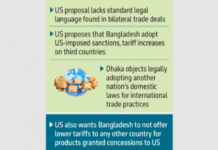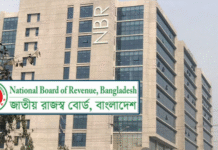
Some days ago, I met a businessman who was contemplating making some fixed deposits. Every time he heard what the existing interest rate was, he became perplexed. He explained in a subdued voice that he helps his village orphanage with the fund and could not compromise with the rate of profit.
It is apparent that the savers of Bangladesh prefer a high rate of interest and they plan to do many things with the profit from their savings. NGOs or cooperatives eye a higher return on their regulatory savings. People today long for a high return on even their insurance schemes, which promise to cover medical expenses during illness.
Banks of Bangladesh have been living under a much-awaited pegged interest rate regime for around four months. Though only the lending rate has been fixed (at nine percent) by the regulator, the deposit rate quite understandably witnessed a sharp decline as a consequence. The best rate of deposit quoted by most banks now hovers at around six percent. As such, if you peep through a bank nowadays, you can’t miss the long queue of gloomy savers. The news media is also abuzz with the tales of savers’ woes regarding the discovery that after inflation, nothing is left for the savers.
We save so we have something to fall back on during a rainy day. We can easily save in the personal vault of our houses. Still, we choose a bank where we opt for security and insulation from inflation. However, if we think to maximise the return from our savings and hope to achieve many things other than protection during a period of hardship, we convert ourselves into investors. In that case, we must also agree to spend our time and energy while bearing a calculated risk.
However, what are our savers doing? They are savers in action and investors in expectation. You will find this genre of savers everywhere in our country. They look for a safe haven for their fund, staying away from risk while desiring the maximum return.
The double benefit or triple benefit scheme is the mostly admired product for savers of rural areas. Foreign remittance rains on these schemes. When banks fail to match the demand matrix for the quickest double or triple benefit, the migrant families move to the newly grown cooperatives or multi-level marketing (MLM) companies only to lose money in the end.
In the book Financially Stupid People Are Everywhere written by Jason Kelly, we find that the first rule of finance is that one needs to consume only 80 percent of their disposable income (i.e., income less taxes). Many people of the developed world save according to this rule. They remain glad as long as their savings fight inflation. The significant rise of deposits in the US to 7.5 percent in 2008 from 2.5 percent in the pre-crisis period, despite zero or negative rate returns, was not a surprise, since people wanted to cushion themselves against the uncertainty. And here reveals the true nature of savings.
In a study, Nobel prize winner Abhijit Banerjee found that people build their houses part by part over many years while the houses remain unfinished without providing any return. Poor people were also found buying fertilisers in advance for use in the crop season. These were the saving behaviours on the part of those people who knew that the money would otherwise be spent.
However, this learning of savings won’t act upon the ever burgeoning “lazy and opportunistic investors”. The government needed to recede from their decision from slashing the rate of Post Office Savings to almost half from existing rates last February. In 2017, our savings-GDP ratio was 31 percent against an investment-GDP ratio of 29 percent. This created a savings glut, which increases the country’s future debt burden.
In fact, a group of new investors have been created in the name of savers who flock to the lure of savings certificates and earn a huge amount of money without any effort. The stimulus packages of Covid-19 is likely to go to the lazy hands of these investors. Our government has also issued a set of reform policies for revitalising the capital market. Still, our savers don’t crowd there to invest. The risk-free rate of 9 to 11 percent on savings certificates is preferred to the risky capital market rate of 11 percent or more.
The “savers in action but investors in expectation” syndrome is failing the single digit interest rate therapy of the government. Due to the profit maximisation orientation of the savers, many banks are still providing seven percent or more on fixed deposits. These banks might save themselves from the present storm, but might sink soon along with its savers.
In 2017, the exchequer received Tk 500 billion from the sale of savings certificates, exceeding the target of Tk 200 billion. If this trend of curtailing the bank’s pie continues, the very objective of the functioning of banks ceases to exist. If the government rather makes the bank the centre of the savings, financial normalcy will resume through the most productive use of money. The government might consider helping the poor or distressed class by direct transfers, closing the chapter of savings certificates altogether.
Savers look best around savings account of banks, while investors around capital market. Savers’ safety can be best protected by banks while the adventurous spirit of investors is best utilised in the capital market. Needless to say, we need both savers and investors for our country. However, taking both forms in one figure, i.e., being a saver in action but an investor in expectation, sounds like a monster threatening to swallow the rather young but fertile financial periphery of our country.
Mohammad Kazi Mamun is an AVP and head of branch at Bank Asia Limited.









